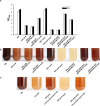Identification and molecular characterization of the homogentisate pathway responsible for pyomelanin production, the major melanin constituents in Aeromonas media WS
- PMID: 25793756
- PMCID: PMC4368426
- DOI: 10.1371/journal.pone.0120923
Identification and molecular characterization of the homogentisate pathway responsible for pyomelanin production, the major melanin constituents in Aeromonas media WS
Abstract
The pigmentation of many Aeromonas species has been thought to be due to the production of a L-DOPA (L-3,4-dihydroxyphenylalanine) based melanin. However, in this study we found that although L-DOPA synthesis occurs in the high-melanin-yielding Aeromonas media strain WS, it plays a minor, if any, role in pigmentation. Instead, the pigmentation of A. media strain WS is due to the production of pyomelanin through HGA (homogentisate). Gene products of phhA (encodes phenylalanine hydroxylase), tyrB and aspC (both encode aromatic amino acid aminotransferase), and hppD (encodes 4-hydroxyphenylpyruvate dioxygenase) constitute a linear pathway of converting phenylalanine to HGA and disruption of any one of these genes impairs or blocks pigmentation of A. media strain WS. This HGA biosynthesis pathway is widely distributed in Aeromonas, but HGA is only detectable in the cultures of pigmented Aeromonas species. Heterologous expression of HppD from both pigmented and non-pigmented Aeromonas species in E. coli leads to the production of pyomelanin and thus pigmentation, suggesting that most Aeromonas species have the critical enzymes to produce pyomelanin through HGA. Taken together, we have identified a widely conserved biosynthesis pathway of HGA based pyomelanin in Aeromonas that may be responsible for pigmentation of many Aeromonas species.
Conflict of interest statement
Figures









References
-
- White LP. Melanin: a naturally occurring cation exchange material. Nature. 1958; 182: 1427–1428. - PubMed
-
- Riley P. Melanin. Int J Biochem Cell Biol. 1997; 29: 1235–1239. - PubMed
-
- Nosanchuk JD, Casadevall A. The contribution of melanin to microbial pathogenesis. Cell Microbiol. 2003; 5: 203–223. - PubMed
-
- Rundgren M. Tritium isotope effects in the reaction catalyzed by 4-hydroxyphenylpyruvate dioxygenase from Pseudomonassp. strain PJ 874. Biochim Biophys Acta. 1982; 704: 59–65. - PubMed
Publication types
MeSH terms
Substances
LinkOut - more resources
Full Text Sources
Other Literature Sources

